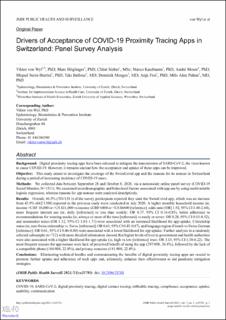Bitte benutzen Sie diese Kennung, um auf die Ressource zu verweisen:
https://doi.org/10.21256/zhaw-21936| Publikationstyp: | Beitrag in wissenschaftlicher Zeitschrift |
| Art der Begutachtung: | Peer review (Publikation) |
| Titel: | Drivers of acceptance of COVID-19 proximity tracing apps in Switzerland : panel survey analysis |
| Autor/-in: | von Wyl, Viktor Höglinger, Marc Sieber, Chloé Kaufmann, Marco Moser, André Serra-Burriel, Miquel Ballouz, Tala Menges, Dominik Frei, Anja Puhan, Milo Alan |
| et. al: | No |
| DOI: | 10.2196/25701 10.21256/zhaw-21936 |
| Erschienen in: | JMIR Public Health and Surveillance |
| Band(Heft): | 7 |
| Heft: | 1 |
| Erscheinungsdatum: | 2021 |
| Verlag / Hrsg. Institution: | JMIR Publications |
| ISSN: | 2369-2960 |
| Sprache: | Englisch |
| Schlagwörter: | COVID-19; SARS-CoV-2; Acceptance; Communication; Compliance; Digital contact tracing; Digital proximity tracing; mHealth; Tracing; Uptake; Usability; Adult; Aged; Contact Tracing; Female; Humans; Male; Middle Aged; Mobile Applications; Surveys and Questionnaires; Switzerland; Physical Distancing |
| Fachgebiet (DDC): | 614: Public Health und Gesundheitsförderung |
| Zusammenfassung: | Background: Digital proximity tracing apps have been released to mitigate the transmission of SARS-CoV-2, the virus known to cause COVID-19. However, it remains unclear how the acceptance and uptake of these apps can be improved. Objective: This study aimed to investigate the coverage of the Swiss Covid app and the reasons for its nonuse in Switzerland during a period of increasing incidence of COVID-19 cases. Methods: We collected data between September 28 and October 8, 2020, via a nationwide online panel survey (COVID-19Social Monitor, N=1511). We examined sociodemographic and behavioral factors associated with app use by using multivariable logistic regression, whereas reasons for app nonuse were analyzed descriptively. Results: Overall, 46.5% (703/1511) of the survey participants reported they used the Swiss Covid app, which was an increase from 43.9% (662/1508) reported in the previous study wave conducted in July 2020. A higher monthly household income (ie, income >CHF 10,000 or >US $11,000 vs income ≤CHF 6000 or <US $6600 [reference]: odds ratio [OR] 1.92, 95% CI 1.40-2.64),more frequent internet use (ie, daily [reference] vs less than weekly: OR 0.37, 95% CI 0.16-0.85), better adherence to recommendations for wearing masks (ie, always or most of the time [reference] vs rarely or never: OR 0.28, 95% CI 0.15-0.52),and nonsmoker status (OR 1.32, 95% CI 1.01-1.71) were associated with an increased likelihood for app uptake. Citizenship status (ie, non-Swiss citizenship vs. Swiss [reference]: OR 0.61, 95% CI 0.43-0.87), and language region (French vs Swiss German[reference]: OR 0.61, 95% CI 0.46-0.80) were associated with a lower likelihood for app uptake. Further analysis in a randomly selected subsample (n=712) with more detailed information showed that higher levels of trust in government and health authorities were also associated with a higher likelihood for app uptake (ie, high vs low [reference] trust: OR 3.13, 95% CI 1.58-6.22). The most frequent reasons for app nonuse were lack of perceived benefit of using the app (297/808, 36.8%), followed by the lack of a compatible phone (184/808, 22.8%), and privacy concerns (181/808, 22.4%). Conclusions: Eliminating technical hurdles and communicating the benefits of digital proximity tracing apps are crucial to promote further uptake and adherence of such apps and, ultimately, enhance their effectiveness to aid pandemic mitigation strategies. |
| URI: | https://digitalcollection.zhaw.ch/handle/11475/21936 |
| Volltext Version: | Publizierte Version |
| Lizenz (gemäss Verlagsvertrag): | CC BY 4.0: Namensnennung 4.0 International |
| Departement: | School of Management and Law |
| Organisationseinheit: | Winterthurer Institut für Gesundheitsökonomie (WIG) |
| Publiziert im Rahmen des ZHAW-Projekts: | COVID-19 Social Monitor |
| Enthalten in den Sammlungen: | Publikationen School of Management and Law |
Dateien zu dieser Ressource:
| Datei | Beschreibung | Größe | Format | |
|---|---|---|---|---|
| 2021_Von_Wyl_Drivers_of_Acceptance_of_COVID-19_JMIR.pdf | 808.1 kB | Adobe PDF |  Öffnen/Anzeigen |
Zur Langanzeige
von Wyl, V., Höglinger, M., Sieber, C., Kaufmann, M., Moser, A., Serra-Burriel, M., Ballouz, T., Menges, D., Frei, A., & Puhan, M. A. (2021). Drivers of acceptance of COVID-19 proximity tracing apps in Switzerland : panel survey analysis. JMIR Public Health and Surveillance, 7(1). https://doi.org/10.2196/25701
von Wyl, V. et al. (2021) ‘Drivers of acceptance of COVID-19 proximity tracing apps in Switzerland : panel survey analysis’, JMIR Public Health and Surveillance, 7(1). Available at: https://doi.org/10.2196/25701.
V. von Wyl et al., “Drivers of acceptance of COVID-19 proximity tracing apps in Switzerland : panel survey analysis,” JMIR Public Health and Surveillance, vol. 7, no. 1, 2021, doi: 10.2196/25701.
VON WYL, Viktor, Marc HÖGLINGER, Chloé SIEBER, Marco KAUFMANN, André MOSER, Miquel SERRA-BURRIEL, Tala BALLOUZ, Dominik MENGES, Anja FREI und Milo Alan PUHAN, 2021. Drivers of acceptance of COVID-19 proximity tracing apps in Switzerland : panel survey analysis. JMIR Public Health and Surveillance. 2021. Bd. 7, Nr. 1. DOI 10.2196/25701
von Wyl, Viktor, Marc Höglinger, Chloé Sieber, Marco Kaufmann, André Moser, Miquel Serra-Burriel, Tala Ballouz, Dominik Menges, Anja Frei, and Milo Alan Puhan. 2021. “Drivers of Acceptance of COVID-19 Proximity Tracing Apps in Switzerland : Panel Survey Analysis.” JMIR Public Health and Surveillance 7 (1). https://doi.org/10.2196/25701.
von Wyl, Viktor, et al. “Drivers of Acceptance of COVID-19 Proximity Tracing Apps in Switzerland : Panel Survey Analysis.” JMIR Public Health and Surveillance, vol. 7, no. 1, 2021, https://doi.org/10.2196/25701.
Alle Ressourcen in diesem Repository sind urheberrechtlich geschützt, soweit nicht anderweitig angezeigt.